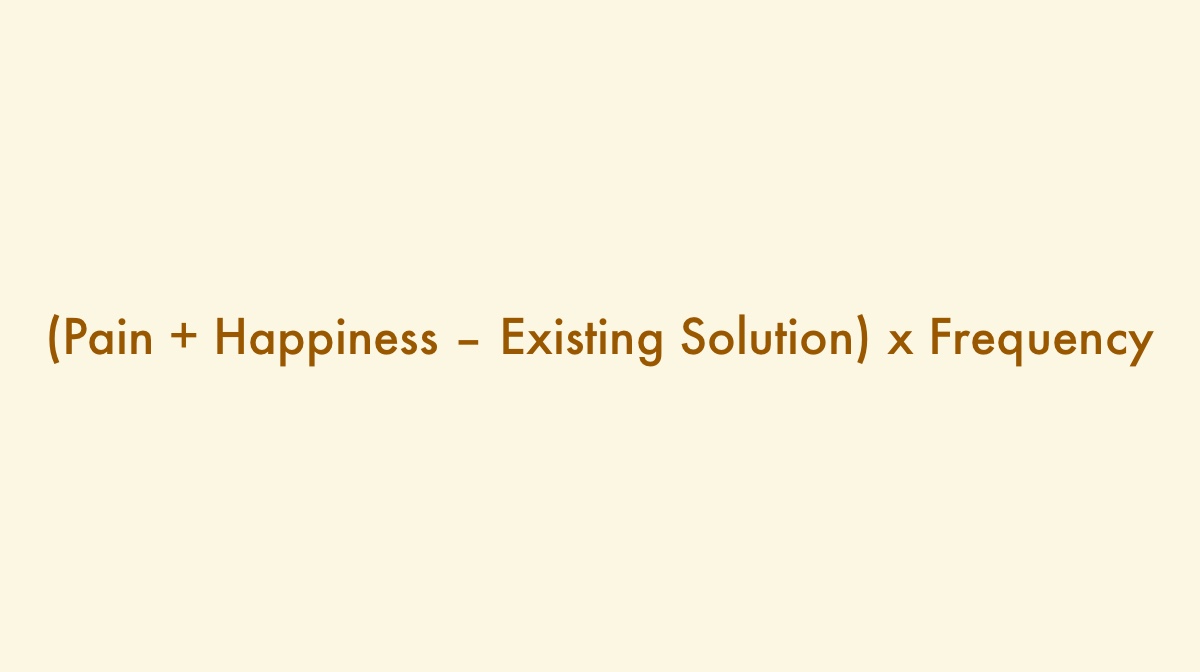With tech products, opportunities are the moments where customers experience pain or have a need to be solved. Some opportunities have a bigger impact than others. Therefore you need a way to identify and prioritize the ones to work on first.
Here’s a formula that we used to build and grow SeaDrive (a learning management system (LMS)) to 100,000+ users. It will help you figure out which projects and opportunities to work on first and which to put off until later.
(Pain + Happiness – Existing Solution) x Frequency = Opportunity Score
Here's a closer look at each variable
Pain
This is a measurement of the level of aggravation or annoyance felt by the customer. It answers the question, “what’s the impact on your customer?” The impact could be inefficiencies, time wasted, lost revenues, costly citations, confusion, etc.
When interviewing customers, have them rate the impact of the problem on a scale of 1-10. Then record it in a central database. As an example, the problem “not knowing who has completed their compliance training” to a safety officer may be pain level 10.
Happiness
Solving a customer problem means helping people achieve a new state. It’s the outcome. There’s the before and the after. What’s the impact of the after? Does it lead to untapped revenues? Maybe it means the customer is the first to know about the latest taco shop in town. What you’re after is understanding how important having the problem solved is.
Again, get a number between the 1-10. And don’t forget, this should be about the desired outcome for the customer, not the company. Those opportunities may need their own formula.
Existing solution
Every problem has existing solutions, even if it means “doing nothing.” You need to figure out what those solutions are and rank the obvious top ones on a scale from 1-10. Some, of course, will rank higher than others. You should be honest when scoring.
You may not identify with a solution or think it’s a bad implementation. But to a customer, it may be a good and realistic option. For example, you may think a CSV import feature is a great way to add new users into a system; it just takes a minute or so, you may think.
A customer, on the other hand, may think otherwise. They may worry about dedicating time to a task they would like fully automated. The point here is, some existing solutions are great. Others less so.
Frequency
How often do customers run up against the problem? Is it once a year or every hour? Frequency matters. A problem that confronts customers more often will increase their level of aggravation. The impact may even be exponential. It’s also good to identify whether multiple customers are experiencing the problem.
It’s better to solve problems that affect as many customers as possible. Otherwise, you’ll put yourself in the position of stealing resources only to help a small minority of customers. Since frequency is time-bound, you could use a range like 1-5, where 1 is rare frequency and 5 is high frequency. Adjust to your needs.
Here’s an example scenario
An architecture firm doesn’t know whether a potential hire has the right experience with AutoCAD.
Pain: 9
The company has been burned a couple of times in the past when they hired an architect who said they knew AutoCAD. This caused projects to be put on hold as more senior architects trained the new hire. They determined it cost more than $10,000 in lost time.
Happiness: 10
Knowing a potential hires skill level is an easy 10. no longer would people need to worry about the wrong person getting through the door. The impact would be huge.
Existing Solution: 4
The solution has been to assign small projects to potential hires and see how well they use AutoCAD. Coming up with tasks that effectively test people is hard and takes time. It also means the tests are appropriate for the type of work specific to the firm.
Frequency: 2
The architecture firm is not rapidly expanding but does hire new architects every quarter. It’s enough to justify a rating of 2.
Result
(9 + 10 – 4) x 2 = 30
Now repeat for this process with each competing opportunity and stack rank them based on their score.
Don’t overthink or over investigate. It’s as much a thinking exercise as it is a practical tool. Data is not perfect. It helps you to make informed decisions rather than blindly moving forward without some form of evidence.
